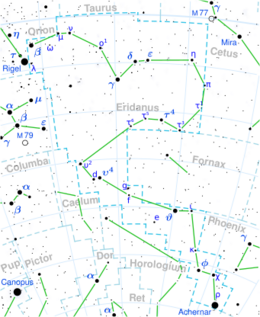Astronomy:HD 27563
| Observation data Equinox J2000.0]] (ICRS) | |
|---|---|
| Constellation | Eridanus |
| Right ascension | 04h 20m 42.8341s[1] |
| Declination | −07° 35′ 32.986″[1] |
| Apparent magnitude (V) | 5.84[2] |
| Characteristics | |
| Spectral type | B5III[3] or B7II[4] |
| Apparent magnitude (U) | 5.23 |
| Apparent magnitude (B) | 5.710 |
| Apparent magnitude (G) | 5.829944 |
| Apparent magnitude (J) | 6.026 |
| Apparent magnitude (H) | 6.109 |
| Apparent magnitude (K) | 6.113 |
| Variable type | SPB[2] |
| Astrometry | |
| Radial velocity (Rv) | 11.20±4.3 km/s |
| Proper motion (μ) | RA: 3.540[1] mas/yr Dec.: −2.298[1] mas/yr |
| Parallax (π) | 3.7763 ± 0.0612[1] mas |
| Distance | 860 ± 10 ly (265 ± 4 pc) |
| Absolute magnitude (MV) | −1.05[5] |
| Details | |
| Mass | 4.3[6] M☉ |
| Radius | 2.8[7] R☉ |
| Luminosity | 687[6] L☉ |
| Surface gravity (log g) | 3.69[6] cgs |
| Temperature | 13,315[6] K |
| Rotational velocity (v sin i) | 34[8] km/s |
| Age | 180[9] Myr |
| Other designations | |
| Database references | |
| SIMBAD | data |
HD 27563, also known by the Bayer designation d Eridani, is a single star in Eridanus, in the direction of the Orion–Eridanus Superbubble,[11] that is faintly visible to the naked eye at a magnitude of about 5.84. Cowley (1972) classifies this star as spectral type B5III,[3] but Houk and Swift (1999) catalog it as B7II.[4]
It was used as a comparison star for 46 Eridani in four separate runs at La Silla Observatory in the 1970s and 1980s,[12] but in 1989, both stars were found to be variable with similar periods of about four days, and HD 27563 assigned the designation EM Eridani.[13] Despite the lack of reliable comparisons for EM Eridani, it was found that the power spectrum of its light curve is remarkably noisy, with two or four prominent oscillation periods centered around 3.9215 d,[13][14] and is classified as a slowly pulsating B-type star.[15]
References
- ↑ Jump up to: 1.0 1.1 1.2 1.3 Brown, A. G. A. (2021). "Gaia Early Data Release 3: Summary of the contents and survey properties". Astronomy & Astrophysics 649: A1. doi:10.1051/0004-6361/202039657. Bibcode: 2021A&A...649A...1G. Gaia EDR3 record for this source at VizieR.
- ↑ Jump up to: 2.0 2.1 Samus, N. N. et al. (2009). "VizieR Online Data Catalog: General Catalogue of Variable Stars (Samus+ 2007-2013)". VizieR On-line Data Catalog: B/GCVS. Originally Published in: 2009yCat....102025S 1: B/gcvs. Bibcode: 2009yCat....102025S.
- ↑ Jump up to: 3.0 3.1 Cowley, A. (1 November 1972). "Spectral classification of the bright B8 stars.". The Astronomical Journal 77: 750–755. doi:10.1086/111348. ISSN 0004-6256. Bibcode: 1972AJ.....77..750C.
- ↑ Jump up to: 4.0 4.1 Houk, N.; Swift, C. (1 January 1999). "Michigan catalogue of two-dimensional spectral types for the HD Stars". Michigan Spectral Survey 5: 0. Bibcode: 1999MSS...C05....0H.
- ↑ Anderson, E.; Francis, Ch. (2012). "XHIP: An extended hipparcos compilation". Astronomy Letters 38 (5): 331. doi:10.1134/S1063773712050015. Bibcode: 2012AstL...38..331A.
- ↑ Jump up to: 6.0 6.1 6.2 6.3 Fouesneau, M.; Andrae, R.; Dharmawardena, T.; Rybizki, J.; Bailer-Jones, C. A. L.; Demleitner, M. (2022). "Astrophysical parameters from Gaia DR2, 2MASS, and AllWISE". Astronomy and Astrophysics 662: A125. doi:10.1051/0004-6361/202141828. Bibcode: 2022A&A...662A.125F.
- ↑ Stassun, Keivan G.; Oelkers, Ryan J.; Pepper, Joshua; Paegert, Martin; De Lee, Nathan; Torres, Guillermo; Latham, David W.; Charpinet, Stéphane et al. (2018). "The TESS Input Catalog and Candidate Target List". The Astronomical Journal 156 (3): 102. doi:10.3847/1538-3881/aad050. Bibcode: 2018AJ....156..102S.
- ↑ Bowman, D. M.; Burssens, S.; Simón-Díaz, S.; Edelmann, P. V. F.; Rogers, T. M.; Horst, L.; Röpke, F. K.; Aerts, C. (2020). "Photometric detection of internal gravity waves in upper main-sequence stars. II. Combined TESS photometry and high-resolution spectroscopy". Astronomy and Astrophysics 640: A36. doi:10.1051/0004-6361/202038224. Bibcode: 2020A&A...640A..36B.
- ↑ Gontcharov, G. A. (December 2012). "Dependence of kinematics on the age of stars in the solar neighborhood". Astronomy Letters 38 (12): 771–782. doi:10.1134/S1063773712120031. ISSN 0320-0108. Bibcode: 2012AstL...38..771G.
- ↑ "EM Eri". http://simbad.u-strasbg.fr/simbad/sim-basic?Ident=EM+Eri&submit=SIMBAD+search.
- ↑ Welsh, B. Y.; Sallmen, S.; Jelinsky, S. (September 2005). "NaI and CaII absorption components observed towards the Orion-Eridanus Superbubble". Astronomy & Astrophysics 440 (2): 547–557. doi:10.1051/0004-6361:20052691. Bibcode: 2005A&A...440..547W.
- ↑ Mathys, G.; Manfroid, J.; Renson, P. (1 March 1986). "Photometric variability of some early-type stars.". Astronomy and Astrophysics Supplement Series 63: 403–416. ISSN 0365-0138. Bibcode: 1986A&AS...63..403M.
- ↑ Jump up to: 13.0 13.1 Manfroid, J. (1 March 1989). "On the Light Curve of HD 27563". Information Bulletin on Variable Stars 3297: 1. ISSN 0374-0676. Bibcode: 1989IBVS.3297....1M.
- ↑ Manfroid, J.; Renson, P. (1 October 1989). "Photometric variations of 46 Eridani and 210 G. Eridani.". Astronomy and Astrophysics 223: 187–195. ISSN 0004-6361. Bibcode: 1989A&A...223..187M.
- ↑ Dziembowski, W. A.; Moskalik, P.; Pamyatnykh, A. A. (1 December 1993). "The opacity mechanism in B-type stars - II. Excitation of high-order g-modes in main-sequence stars.". Monthly Notices of the Royal Astronomical Society 265 (3): 588–600. doi:10.1093/mnras/265.3.588. ISSN 0035-8711. Bibcode: 1993MNRAS.265..588D.
 |


